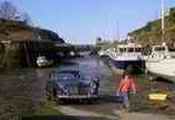volvodspec wrote:my 343 is also equipped with one of these, no problems on assembly and a perfectly working LSD
Maybe you know what you are doing

I was told this was a straight swap with no special tools. I didn't know anything about bearing preload or backlash, until now(ish). What torque did you use for the crown bolts, was the insert flush?
Anyway I have been thinking about how to do the preload after watching youtube, which according to the university guy these things are important for lifetime and noise. Although mine was fine with a bit of backlash for the 5 miles I used it, except the fact it was locked up.
Regarding backlash the output bearing preload is not related to backlash as such.
Bearing preload is related to right shim+left shim (squeeze between the sides)
Backlash is related to left shim mainly (position across the diff)
The procedure is to start with bearing preload but it seems to be without the pinion installed. Unless the pinion is loose I'd leave it in, so we need procedure which involves this.
Generally we can add torques, so if we can measure the baseline pinion torque at the output flange with effectively zero pre-load, we then can add on the requirement for the output bearing.
Alternatively, we might put the small shim in the LHS and make a big backlash (default is 1mm LHS, 0.8mm RHS, mine was 1+0.45), making the crown free to move for the back lash with maybe enough space to measure the torque directly.
There could be other variables, but doing both might give some confidence.
What I am not sure about is whether we need the starting torque or turning torque, although maybe the difference is small. Anyhow I plan to use a fibre glass rod with a sliding 0.5kg weight on it mounted on a drive flange.
We now have to keep the sum of the shims the same, so to control backlash any thing we take off one side we have to add to the other.
As to assuming ball park when assembled with the same shims, well I hope so but even putting in another Volvo diff or even the same diff with new bearing the manufacturer did not want to assume anything. Bearing preloads are controlled with very small changes.

